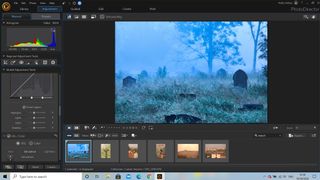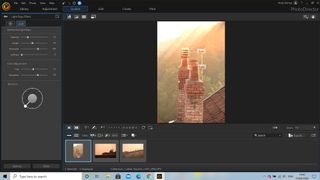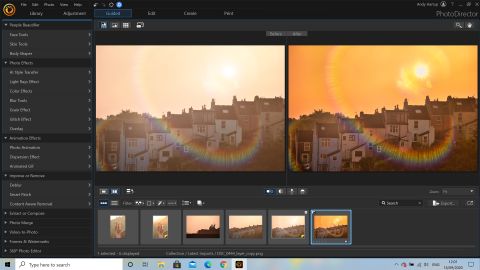CyberLink PhotoDirector 12 is available now, and this updated version brings a handful of new and very flashy features to the program. It's part of the CyberLink Director Suite 365, and the focus with PhotoDirector 12 is on creation, composition, and ease of use - essentially the aim is to make your photos not only better, but enhanced to make truly original images. Having tested the new version of PhotoDirector for while now, we’ve been able to create both wonderful and bizarre compositions, so the results of the new features are definitely mixed. One thing remains consistent, though, and that’s how easy it is to edit and enhance photos with CyberLink’s suite. That’s why it has moved up our list of the best photo editing software, and now sits behind the Adobe CC programs.
CyberLink PhotoDirector 12 review: Features
The headline improvements for PhotoDirector 12's toolset are dispersion effects and image motion, along with powerful AI-driven cropping and background-swapping enhancements. One definitely works more effectively than the other, although this very much depends on the starting image you’re working with. Dispersion is, for us, the standout - you can essentially add animated particle effects to your photos, to bring them to life. One example we created was making blossom float gently away from a cherry blossom tree, and while there isn’t a specific petal shape, we found that the oval or heart shapes worked well unless we increased the particle size dramatically.
While it’s fun, we didn’t enjoy the animation effects as much. They’re great for things like making waves roll into a beach scene, but we struggled to make the animations look natural in many other circumstances. These effects feed more into any surreal or exaggerated images you may want to create, which is something CyberLink is keen to showcase with PhotoDirector 12.
Outside of these headline features, adjustments have been made to other areas of the editing experience. You can apply several standard edits to your photos, and if you’re just enhancing them, you’ll likely be working in the Adjustment and Guided tabs. The program offers tools for color management, background removal, and shapes. It also includes a skin smoother, a teeth whitener, a red-eye remover and a body shaper you can use to edit the subjects in your photos. There are loads of masks and effects for adding additional texture and style to your images, and while many will be of limited use to most, you’ll find the light rays and lens flare features effective and simple to apply. When you’re purely enhancing images, PhotoDirector 12 really is one of the easiest programs on the market, and beginners will get a serious wow-factor in minutes, rather than hours. Compare this to something like Affinity Photo, and it's night and day. Our main (admittedly minor) issue is that it’s easy to over-work an image too, and while there are some excellent guides in the app, the sliders can make drastic changes that are harder to balance out. This is where Adobe Lightroom still has an edge.

In terms of the full-on editing options, this retains the simplicity, but adds more design options. The Layers tab allows you to work with and edit layers. There are also a bunch of blending modes and a selection of tools that add text, fills and gradients to your images. There are cloning tools to help you remove spots or blemishes, although it doesn't have as many options as Adobe PhotoShop CC. We like the smart object removal and cropping options in PhotoDirector 12, which are AI-driven, and they’re largely effective providing you’re not working with busy images that feature similar color tones. PhotoDirector can also create and enhance panoramic pictures and HDR images, too, and the results you can achieve here are fantastic.
One excellent new feature that comes with 365 is the ability to access a stock image library from Shutterstock, for free. This means that if you’re looking to blend your images with different backgrounds or scenes, it’s easy to do so. While pure or hobbyist photographers won’t necessarily want to blend original and stock photos, it’s great for fun stuff like inserting yourself into different scenes, or popping your friends into different backgrounds.
As is standard across premium photo editors, if you have images with distortions caused by your camera’s lens, or you experience any chromatic aberration, you can use the lens distortion correction tool to fix this. PhotoDirector has batch processing, so you can apply the same edit to multiple photos at once, which saves you loads of time and work if you’re sifting through multiple shots taken on the same settings. In terms of organizing your edits, we love the fact you can put ‘Before and After’ images next to each other, and that you can toggle between thumbnails and list views, but we prefer the grid views in Lightroom.
Overall, we love how easy PhotoDirector’s editing and enhancement tools are - they make the process simple for users of all skill levels, and help you create stunning images fast. There’s perhaps a lack of subtlety to some of it, but skilled editors will work around this, and there are plenty of tutorials to help you balance out your edits.
CyberLink PhotoDirector 12 review: Organization and export options
The Library tab houses the image editor’s organizing system, and you can import photos individually, by folder, or directly from your camera and then organize them into categories. You keep track of your photos by applying tags and keywords to them, and there’s also a face-tagging function so you can search images with a specific person in them. This face recognition organizer is especially good - it’s accurate and simple to use. While we don’t quite like the layout of the organizer as much as some (but not all) rivals, we still think it's one of the best software options for organizing your photos overall.
While the photo editor has a wide variety of editing tools, the organizer and exporter lacks some file compatibility. It can work with various video and audio files, which is useful when you’re exporting animated images, but it only supports six photo file formats: RAW, JPG, PNG, PHI, GIF and TIF. To an extent, this limits the kinds of projects you can create, as well as what images you can import into the software - you won’t be directly importing Photoshop projects into PhotoDirector.

As part of the CyberLink Director 365 suite you get 50GB of cloud storage too, so you can access your projects and assets wherever you are, provided you have a WiFi connection. This means you can edit on your computer, and your photos are shared with the app you can download to your phone. So, if you’re looking to post your creations to Instagram, which has no web-upload options, this does make the process easier (and there’s no need to use Insta filters either).
The app itself is simple to use, and mirrors the functionality of the desktop version well. It isn’t 100% stable, and you will occasionally get syncing errors with your photos, but it works fine almost all the time. If you’re away from your home, it’s a great way to make quick edits on your photos, if you want to share them straight away.
CyberLink PhotoDirector 12 review: Price and support options
Ok, so you have a number of options when it comes to paying for CyberLink PhotoDirector 12. We tested and recommend the PhotoDirector 365 version, which gets you PhotoDirector 12 along with 50GB of online storage for around $55 per year. You'll usually find this reduced to $40 per year, which is an absolute steal. If you want to pay monthly, this cost rises a little (depending on offers).
You can also buy a lifetime license for PhotoDirector 12 for around $100 but... we'd probably recommend going with the 365 option. Sure, you'll technically win if you use PD12 for more than 3-4 years, but you'll likely miss out on new features that come along with future versions, and you won't get the cloud storage.
If you get the 365 version you’ll also get premium support and access to updates, design packs, and other plugins for free, which can save you a stack of money if you like to bolt-on features to your core editor.
If you're looking to do video editing too, there are bundles that save you money on PhotoDirector and the new version of PowerDirector. The Director Suite 365 gets you Photo and PowerDirector for $97 per year, and that's exceptional value. There are discounts for students and teachers, and a free trial available too.
CyberLink offers support for PhotoDirector both within the program and on its website. You can access video tutorials, product FAQs, and user forums that discuss common problems and solutions. The company also lists a support email address and phone number.

Should you buy CyberLink PhotoDirector 12?
Yes, you should. Unless you’re locked into the Adobe ecosystem (which is no bad thing), we definitely recommend trying out PhotoDirector 12 in either the single download or 365 format. What sets it apart is how easy it is to use, yet how deep you can go with the features. Simple, effective photo enhancements can be made in minutes, and batch-copied to all your edits, and you can be ready to share or print an optimized photo very quickly.
While the layout and guide content isn’t quite as slick as Lightroom, the fact that PhotoDirector integrates full editing and enhancing features in one program makes it easier to use for beginners and more casual users. The new features are well worth an upgrade, if you’re interesting in creating more than just regular photos, and the value you get here with the cloud storage and Shutterstock access is unrivalled.
Should you abandon the good ship Adobe CC and migrate over to PhotoDirector? You’ll likely miss some of the more advanced editing features of Photoshop, and the layout of Lightroom, but if you’re a newbie looking for something integrated, easy to use, and simple to get stand-out results with… you should definitely give the trial version a download.



